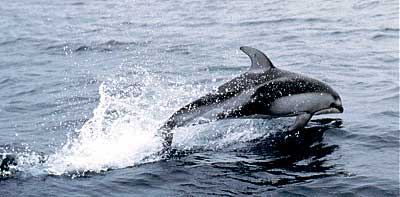Scientific Uncertainty

Aerial photograph of North Atlantic right whale and calf. Photo courtesy of New England Aquarium.
In the scientific process, absolute certainty is often difficult to achieve. Uncertainty is a factor of the process {method link} and does not mean that a result, hypothesis, or theory is wrong. Scientists have developed formal methods to address scientific uncertainty. Outside the scientific community, these methods and associated terminology can be confusing. This may lead to incorrect conclusions about the validity of the science.
Most people think of uncertainty as an absence of knowledge. However, in science, uncertainty is used as a measurement to tell us how well something is known. Scientists almost always include the level of uncertainty in a discussion of scientific results. By quantifying how much uncertainty is associated with results, scientist are able to communicate their findings more precisely.
Scientific uncertainty generally means that there is a range of possible values within which the true value of the measurement lies. Further research on a topic or theory may reduce the level of uncertainty or the range of possible values. At times, the public or the media interpret scientific uncertainties as synonymous with doubt. This can unfortunately discredit research findings whereas reporting the level of uncertainty strengthens the research results and provides guidance for the focus of future research projects. Scientific uncertainty is a bedrock concept of science that makes the results stronger and more useful.
Uncertainty in the scientific process includes several kinds of uncertainty: statistical uncertainty, natural variability, and true uncertainty.
Statistical uncertainty involves a measured range of variability. An example of statistical uncertainty is the accuracy with which the speed of sound in seawater can be determined. Any effort to measure sound speed has, for example, some measure of uncertainty in the distance over which the sound traveled; the temperature, pressure, and salinity of the water; and the measurement of the travel time. [See Statistical Uncertainty – measurement errors]

Pacific white-sided dolphin. Copyright Tom Kieckhefer.
Unlike statistical uncertainty described above, where there is only one true value that exists within a statistically defined range of values, biological systems have an uncertainty associated with the range of natural variability. For example, in mammals, the softest sound that an animal can hear at different frequencies will vary between individuals, and, in a single individual, these levels may vary over time. The best hearing level at a frequency includes uncertainty because of this natural variability in hearing levels across individuals. Research on human hearing levels provides a range of hearing levels. [See Statistical Uncertainty – natural variability]
True uncertainty is where there is a question regarding the cause, result, or probability of an effect. A scientist understands that at any time, someone else may prove them wrong or refine what they have done. Depending on the science at hand, there can be a range of uncertainty.
Scientific uncertainty is especially difficult to consider in the scientific process when it affects health, safety, and the environment. A challenge arises as potential risks are observed and scientists are unable to determine an absolute cause and effect. To mitigate or regulate environmental problems, policy makers and environmental regulators often look to the scientific community for absolutes and certainty. However, data from environmental studies related to health, safety, and the ecological consequences of human actions may not provide the level of scientific certainty that policy makers and regulators need. In many cases, statistical probabilities are the best answers that scientists can provide. Those statistical probabilities, along with other information, can be used to produce levels of risk which can be used by policy makers and regulators when making their decisions.